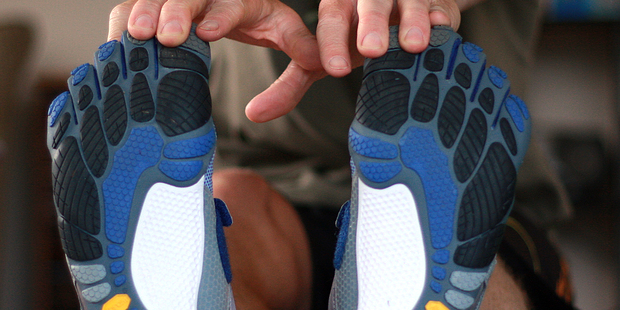Unhappy Feet (A Brief History of Misadvertised Fitness Footwear)
 Being fit is this millennium’s mantra and a fashionable lifestyle choice, all rolled into one neat package. Everywhere you turn, statistics warn about the dangers of rampant obesity, the myriad health issues stemming from leading a largely sedentary life and how processed foods will eventually lead to your demise. And, as luck would have it, media provide a ton of placating answers to the panic they themselves helped spread: there’re the miracle diets, the incredible fitness regimens, the advanced ab-shaping technology — all designed to make you healthier and more fit. But, as it turns out, shoehorning fitness and clean living into some aspects of one’s life may not be such a good idea…
Being fit is this millennium’s mantra and a fashionable lifestyle choice, all rolled into one neat package. Everywhere you turn, statistics warn about the dangers of rampant obesity, the myriad health issues stemming from leading a largely sedentary life and how processed foods will eventually lead to your demise. And, as luck would have it, media provide a ton of placating answers to the panic they themselves helped spread: there’re the miracle diets, the incredible fitness regimens, the advanced ab-shaping technology — all designed to make you healthier and more fit. But, as it turns out, shoehorning fitness and clean living into some aspects of one’s life may not be such a good idea…
Back in 2009, in the wake of the economic crisis a lot of health-conscious people were looking for cheaper solutions to pricey gym memberships and expensive diets. Various TV programmes related to health and fitness explored ways of getting in shape on a shoestring budget. Many of those exercises, media claimed, would give one rush of endorphins they would never hope to get working out at the gym. And so, people started to take an interest in cross-fitness (a type of exercise that combines many types of physical activity), rediscovered triathlons (remember Ironman events?) and, finally, began exploring the joys of walking and running.
Yet in the latter case, it’s not simply moving around on one’s own two feet that got people so excited. The modern fitness fan has to be as tech savvy as possible; if it hasn’t been tweeted or instagrammed, it didn’t happen. If space-age research didn’t help build it, it isn’t sexy or attractive to the consumer. Therefore, plain old bipedal movement had to be refined with the use of proper paraphernalia, shoes being the prime piece of kit to be upgraded. And since being healthy and fit is now mandatory, shoes should not only help you get a move on, but should help you lose weight, improve your muscle tone and achieve that elusive media-promoted body image you so strive for.

The two trends converged in 2008, with the newly introduced fashionable and ultra-modern toning shoes. They combined the new-found joy of running with our constant desire for gadgets and tech. Toning footwear thus gained a sizable market foothold, starting out with just around USD 18 mln in revenue. In 2009, it was already USD 145 mln. Following a boom in viral marketing and generally positive press, by 2010 toning shoes became exceedingly popular. ConsumerReports claim that by that time, the market for special toning shoes ballooned to USD 1 bln a year; not your penny loafers, then.
 For a while it seemed as if the toning shoes were a shoo-in for the title of the most popular fitness accessory out there, and not without good reason. It does sound nice on paper: the sole of the shoe is made thicker in the middle and filled with air bubbles that move unpredictably throughout the empty areas inside, creating a feeling of walking in the shifting sand. The resulting imbalance causes you to work out even while you’re simply standing. This is possible because your muscles are constantly trying to offset the feeling of instability introduced via the air pockets. Sounds very enticing – who wouldn’t want to exercise while simply standing in the line to Maccy D’s, right?
For a while it seemed as if the toning shoes were a shoo-in for the title of the most popular fitness accessory out there, and not without good reason. It does sound nice on paper: the sole of the shoe is made thicker in the middle and filled with air bubbles that move unpredictably throughout the empty areas inside, creating a feeling of walking in the shifting sand. The resulting imbalance causes you to work out even while you’re simply standing. This is possible because your muscles are constantly trying to offset the feeling of instability introduced via the air pockets. Sounds very enticing – who wouldn’t want to exercise while simply standing in the line to Maccy D’s, right?
However, even as early as in 2009, one CNN article cited some sports doctors as saying that simply making people strain their muscles isn’t the same as exercise. One doctor explained that someone walking with a limp actually strains their muscles to a greater extent than a person walking normally, but that alone doesn’t make that person any healthier or more fit. Following mixed messages from the experts, the FTC — the American federal-level watchdog organization that aims to protect the customer — started to investigate the claims that toning shoes do, indeed, help tone one’s muscles.

The first company the FTC has put the boot in was Reebok, one of the stalwarts of the sporting goods market and a generally reputable company. Their line of EasyTone sneakers promised to improve buttock muscle’s (the gluteus maximus in scientific parlance) strength and tone by 28%, give 11% more strength and tone in the calf, and boost hamstring muscles’ tone by further 11%. All of that numerical goodness, and according to one ad, achieved just by walking in those shoes. It would probably not be that big of a deal were those your regular sneakers. But these were specialized walking (EasyTone) and running (RunTone) shoes that retailed from USD 80 to 100 a pair, with specialized EasyTone flip-flops setting one back around USD 60.

When the FTC investigated Reebok’s data more closely in 2010, they found out that none of the physical benefits were based on solid evidence. At that price point, that would make for one expensive wardrobe stuffer outside of walking or running season no matter which of the options you’ve picked – 60 or 80 bucks may buy two pairs of less fitness-oriented shoes, after all. After cries of outrage from all corners of the press, Reebok had to settle for USD 25 mln. To dissuade other companies from doing the same, the FTC also warned that it „wants national advertisers to understand that they must exercise some responsibility and ensure that their claims for fitness gear are supported by sound science.” To boot, Reebok had to give their customers an option to get a refund via a special site, without any unnecessary formalities.
Was that a sign that some companies got too big for their boots, so to speak? Apparently so. Alongside Reebok, other companies were also trying to get their foot in the door. A sports apparel company Skechers USA, Inc. (a not at all sketchy-sounding name) didn’t start quaking in their shoes at the FTC’s warning, though they probably should have, since their main product were „unstable” shoes (retailing at USD 60 to USD 100 per pair) which debuted in mid-2010. These included the imaginatively named „Resistance Runner”, „Toner”, „Shape-up” and „Tone-up” lines of footwear, which promised more than just toning up muscles. „Skechers’ unfounded claims went beyond stronger and more toned muscles. The company even made claims about weight loss and cardiovascular health,” explained FTC’s David Vladeck.

Skechers weren’t just misleading their customers by vaguely phrased promises, either. Several celebrities were hired to pitch the shoes miraculous properties – Brooke Burke flashed her beautiful smile, Kim Kardashian showed off her sultry body in a steamy Super Bowl ad… In short, Skechers were conducting a very aggressive campaign, basing all of it on the premise of health benefits achieved by wearing their product. FTC didn’t take too long to notice, fortunately. By 2012, Skechers were ordered to pay up and fess up; that payment was to the order of USD 40 million, but the fessing up never materialized.
Bonnie Patton of the consumer advocacy group „Truth in Advertising” had this to say about the USD 40 mln settlement; „[there’s not] one shred of data to support the idea that this is a just or reasonable number. My guess is that [Skechers’] marketing campaign costs more than that every year.” Indeed, compared to the whole market it seems a small number, and since Skechers constantly evolve and are still available on the market, they might have only considered that a slap on the wrist. Vladeck subsequently explained that „The FTC’s message, for Skechers and other national advertisers, is to shape up your substantiation or tone down your claims.”

 Which brings us to 2014. You’d think that after the Reebok’s and Skecher’s misadventures the industry would have learned its lesson and stopped forcing dubious data down the gullible fitness aficionado’s gullet… but that has not been the case. Enter Vibram – the five-fingered… No, not glove. A runner’s shoe. Unlike Reebok and Skechers, Vibram offers minimalist „barefoot” running shoe, first put onto the market way back in 2006. In 2007, their five-toed shoe was named one of the best inventions in the health industry that year by the Time magazine, while a very popular 2009 book entitled „Born to run” helped cement its reputation. Over the years a whole culture of barefoot running emerged, owing its success to Vibram’s aggressive campaign of the sport itself.
Which brings us to 2014. You’d think that after the Reebok’s and Skecher’s misadventures the industry would have learned its lesson and stopped forcing dubious data down the gullible fitness aficionado’s gullet… but that has not been the case. Enter Vibram – the five-fingered… No, not glove. A runner’s shoe. Unlike Reebok and Skechers, Vibram offers minimalist „barefoot” running shoe, first put onto the market way back in 2006. In 2007, their five-toed shoe was named one of the best inventions in the health industry that year by the Time magazine, while a very popular 2009 book entitled „Born to run” helped cement its reputation. Over the years a whole culture of barefoot running emerged, owing its success to Vibram’s aggressive campaign of the sport itself.
Barefoot running is supposedly natural for the human body, following the notion that primitive humans ran a lot before the shoes were even conceived. The conveniently forgotten lack of concrete roads back in the stone age doesn’t deter lovers of barefoot running, even though the science is inconclusive at best with regard to the exercise’s safety in our urban environments, not to mention any possible health benefits. Various studies show time and again that while in some cases, barefoot is ok, it’s doing more harm than good in the long term. Clearly, Vibram’s advertising which claimed otherwise is baseless or misleading.
So, if Reebok had to give back its customers back USD 25 mln and Skechers had to refund USD 40 mln, Vibram will probably go belly up in the wake of the FTC’s terrible comeuppance, right? Wrong! Earlier this month, the FTC ordered Vibram to pay up just around USD 3.75 mln to any people that bought their barefoot shoes after 2009. That’s around 70 000 customers who will get their money back, and just a tenth of what Skecher’s customers received in total. But just like Reebok and Skechers earlier, Vibram has refused to admit any wrongdoing whatsoever. You see, running one’s mouth is still the healthiest, most efficient way to exercise,
apparently…

fit – w formie
fashionable – modny
X all rolled into one – (wiele) X w jednym
rampant – szerzący się, szalejący
obesity – otyłość
myriad – miriady, ogrom
to stem from sth – wynikać z czegoś, być czymś wywołanym
sedentary – siedzący
processed – przetworzony
demise – zgon, śmierć
to provide – zapewniać, dostarczać
placating – uspokajający
to spread – siać, szerzyć
miracle – cudowny
regimen – reżim, plan (np. ćwiczeń)
ab – mięśień brzucha
to shoehorn sth into sth – wcisnąć coś gdzieś na siłę
in the wake of sth – w następstwie czegoś
conscious – świadomy
pricey – drogi (pot.)
gym – siłownia
membership – członkostwo
various – rozmaity
to get in shape – wyrobić sobie formę, nabrać formy
a shoestring budget – bardzo ograniczony budżet, głodowy budżet
to claim – twierdzić
rush – zalew, nagły przypływ
to work out – ćwiczyć (fizycznie)
cross-fitness – trening kross-fit
to combine – łączyć
to rediscover sth – ponownie coś odkryć
latter – ten drugi, ostatni (z wymienionych)
excited – podekscytowany
tech savvy – znający się na technologiach
space-age – związany z epoką kosmiczny, tu: najnowocześniejszy
research – badanie, badania
plain old – zwykły, nieciekawy
bipedal – dwunożny
to refine sth – udoskonalić coś
paraphernalia – akcesoria, sprzęt
prime – podstawowy, najważniejszy
piece of kit – sprzęt, sprzęcior (pot., UK)
to upgrade – unowocześnić, udoskonalić
mandatory – obowiązkowy
to get a move on – ruszyć się (z miejsca)
to improve – poprawić, ulepszyć
muscle – mięsień
tone – tu: tonus
elusive – nieosiągalny
to strive for sth – dążyć do czegoś, zabiegać o coś
to converge – zbiegać się
introduced – wprowadzony (np. na rynek)
new-found- nowo odkryty
constant – stały
desire – potrzeba, chęć
tech – technologia, technologie (pot.)
footwear – obuwie
sizable – pokaźny
foothold – przyczółek, punkt zaczepienia (np. na rynku)
revenue – przychód, wpływy
following X – w następstwie X, po X
viral marketing – marketing wiralny, marketing w sieciach społecznościowych
exceedingly – nadzwyczaj
to balloon – gwałtownie zwiększyć się
penny loafer – mokasyn pensowy
to be a shoo-in for sth – być pewniakiem, być faworytem do czegoś
sole – podeszwa
thick – gruby
to fill sth with sth – wypełnić coś czymś
unpredictably – w sposób nieprzewidywalny
throughout – przez
shifting – przemieszczający się, tu: przelewający się
resulting – wynikający (z czegoś), będący skutkiem
imbalance – brak równowagi
to offset sth – zrównoważyć coś
instability – niestabilność
via – za pośrednictwem, przez
enticing – zachęcający, kuszący
Maccy D’s – McDonald’s (pot., UK)
to cite sb as saying – przytaczać czyjeś słowa, cytować kogoś
to strain – wysilać (się), napinać (się)
to walk with a limp – kuleć
to a greater extent – w większym stopniu
mixed – mieszany, niejednoznaczny
watchdog – ciało nadzorujące
to investigate sth – badać coś
to put the boot in – skrytykować (kogoś) ostro (pot., UK)
stalwart – tu: stały przedstawiciel, stały gracz
generally – ogólnie
reputable – szanowany
sneaker – tenisówka (US)
buttock – pośladek
scientific – naukowy
parlance – żargon
calf – łydka
to boost – umocnić, wzmocnić
hamstring – ścięgno stawu skokowego
goodness – tu: korzyści
to achieve – osiągnąć
not that big of a deal – nic wielkiego, nic takiego
regular – zwyczajny
to retail at X – być sprzedawanym po X, kosztować X w detalu
flip-flop – japonka
to set sb back (by) X – kosztować kogoś X (pot.)
benefit – korzyść
evidence – dowody
price point – pułap cenowy, cena
wardrobe stuffer – tu: nieużywana odzież
to pick – wybrać
buck – dolec (pot. o dolarze)
outrage – oburzenie
to settle for X – tu: dojść do ugody w wysokości X (o kwocie odszkodowania bez procesu sądowego)
to dissuade sb from doing sth – odwieść kogoś od (z)robienia czegoś
to warn – ostrzec
advertiser – reklamodawca
to exercise sth – wykazać się czymś
responsibility – odpowiedzialność
to ensure – zapewnić
gear – sprzęt
sound – uzasadniony, staranny
to boot – co więcej
refund – zwrot pieniędzy (przy reklamowaniu produktu)
to get too big for one’s boots – zważnieć, zacząć zadzierać nosa
alongside – obok, oprócz
to get one’s foot in the door – ustawić się, znaleźć się w doskonałej pozycji (do dalszego rozwoju)
apparel – odzież
sketchy – niekompletny, pobieżny
to quake in one’s shoes/boots – dygotać ze strachu, spietrać się
per pair – tu: za parę
imaginatively – z polotem
resistance – opór
to shape up – nabrać formy
unfounded – nieuzasadniony, bezpodstawny
cardiovascular – sercowo-naczyniowy
to mislead sb – zwodzić kogoś
vaguely – mgliście, niejasno
to phrase sth – sformułować coś
celebrity – sława, znakomitość
to pitch sth – tu: wkręcać coś, przekonać kogoś do czegoś
to flash sth – obnosić się z czymś, błysnąć czymś
to show sth off – chwalić się czymś, popisywać się czymś
sultry – zmysłowy, seksowny
steamy – parujący, tu: gorący, namiętny
Super Bowl – puchar/finał mistrzostw futbolu amerykańskiego
ad (advertisement) – reklama
to conduct – przeprowadzać
premise – przesłanka
to pay up – spłacić, zapłacić
fess up – przyznać się do zrobienia czegoś złego (pot., US)
to/in the order of X – w granicach X
to materialize – ziścić się, spełnić się
advocacy – tu: organizacja wsparcia (jakiejś grupy społecznej)
shred – ślad, cień (czegoś)
data – dane
just – słuszny, zasadny
reasonable – rozsądny
my guess is… – sądzę, że…, według moich szacunków,…
compared to – w porównaniu do
to consider sth sth – uznać coś za coś/jakieś
a slap on the wrist – tu: lekka kara, upomnienie
subsequently – później
substantiation – uzasadnianie, udowadnianie (czegoś)
to tone sth down – zmniejszenie czegoś, zredukowanie skali/wielkości czegoś
misadventure – nieszczęśliwy przypadek
to force sth down sb’s gullet – wmusić coś, wepchnąć coś komuś do gardła
dubious – podejrzany
gullible – naiwny
aficionado – fan, wielbiciel
barefoot – bosy
toe – palec stopy
invention – wynalazek
entitled – zatytułowany
to cement sth – przypieczętować coś, scementować
to emerge – powstać
notion – przekonanie, idea
primitive – pierwotny
to conceive sth – wymyślić coś, wykoncypować
conveniently – wygodnie, niby przypadkiem
concrete – beton
stone age – paleolit, epoka kamienia łupanego
to deter sb – odstraszać, odstręczać kogoś
inconclusive – niejednoznaczny, nieprzekonujący
with regard to sth – odnośnie (do) czegoś
urban – miejski
study – studium, badanie
harm – szkoda, krzywda
in the long term – na dłuższą metę
baseless – bezpodstawny
to go belly up – splajtować (pot.)
comeuppance – zemsta, pomsta
in total – łącznie
to refuse – odmówić
to admit sth – przyznać coś
wrongdoing – przestępstwo, zły uczynek
to run one’s mouth – gadać za dużo lub bez sensu (pot., US)
efficient – wydajny
by Prochor Aniszczuk







